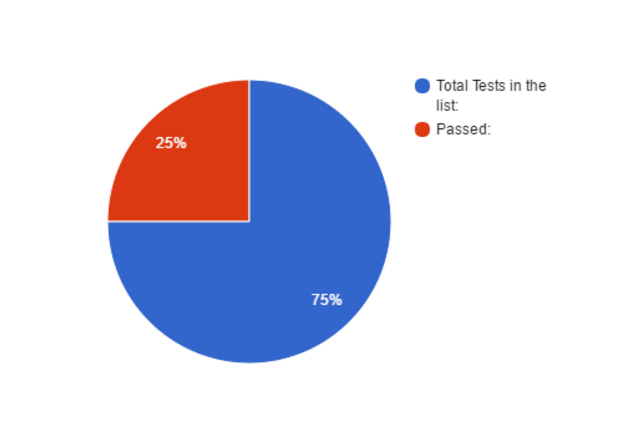The Art of Creating Software Testing Checklists and Presenting Testing Data Clearly

Creating an efficient and well crafted test checklist requires not only personal experience and deep knowledge of the topic, but also an understanding of the end-user’s philosophy and expected experience. QA and software testing checklists must include the following:
- a strong title that clearly represents the purposes of the checklist,
- a clear description with all of the actions’ sequences,
- the list of testing prerequisites, and
- the list of expected results (optional).
To ensure a product owner that the software product is tested properly, all of the points above should lead to the coverage of all the business and functional requirements. In this article we will review 2 main factors that will help you test your app and cover all the critical issues:
- How to make an efficient testing checklist.
- How to present testing data to help developers interpret it correctly.
If you want to be sure that your QA team executed all the steps correctly and tested your app or product properly, this article is a must read in your reading list. Ready to start? Our journey begins!
How to make an efficient software testing checklist
The main goal of every test checklist is to help its executor say “yes, I’ve checked every step in this set of tasks”. Therefore, we’d like to outline 7 tips that will help you write an efficient test checklist:
1. Make a blueprint - The author of the test checklist needs to complete the following steps before starting a testing checklist:
- get the details of a product specification;
- define the test environments, test data, and test scripts; and
- determine your testing team, their responsibilities, and deliverables.
2. Be clear - When a QA manager starts writing a checklist he must always remember that all the points in it should be defined correctly. They should not contain options for discretionary interpretation.
| Also read: Machine Learning Software Testing: how to develop and test machine learning scripts for iOS
3. Group testing points - It is not necessary to place all the points in one list. It is possible to make several subgroups in the checklist. This approach will minimize the chances of losing some points while working.
4. Create the flow from an end-user’s perspective - The ultimate goal of the test checklist is to meet the customer’s requirements. A QA manager must keep in mind the user’s logic. That will help avoid two common mistakes:
- overlooking critical bugs, and
- writing points in a checklist that do not cover real life scenarios.
| Also read: Mobile Application Testing Checklist
5. Make comments - Software testisng checklists should include a general statement which tells QA managers what to test. But if comments can help testers check an app correctly, they must be added (no kind of new Lord of The Rings story is required).
6. Write a checklist in an organized manner - A tester must write down a clear testing flow and avoid duplications in the description.
7. Maintenance and updates of the notes - It is always good practice to update test checklists as per the newly introduced changes in the requirements.
| Also read: 508 compliance testing checklist for mobile apps
These 7 tips will help you put together an efficient checklist, but keep in mind that they will only get you half the way there. The second half will be in the presentation of the results obtained from good testing. It helps development teams spend less time on reviewing information, reproduce the issues, and planning future iterations.
How to present software testing checlist's data results
It may be just human nature, but many people throughout the world think alike, whereas they perform the same user experience flow for all types of their activities:
- they try a new thing with 100% concentration,
- they then find out how to reproduce the same actions with less efforts, and after that,
- try to perform the same actions without having to think about them.
It means that nobody wants to do algebra in their heads when reviewing test results. When combining a new test, you need to keep in mind the type of information readers are looking for, and how to make this information logical and visually clear. Quality assurance checklists must clearly present the following information:
- the testing progress (the percentage of executed tests), and
- the app’s or website’s testing status at the current moment (the percentage of tests that have passed or failed).
Let’s take a look at the following examples:
| Example #1 | Example #2 |
|---|---|
| Total tests in the list: 1200 Checked: 401 Passed: 301 Failed: 80 In progress:20 | Total tests in the list: 1200 Checked: 33% (401/1200) Passed: 25% (301/1200) |
As you can see, it is the same data but
- it is provided in a different manner, and
- ‘Example #2’ is much easier to read.
To make it even easier, we have created a pie chart:

Based on the information we’ve provided above, we’d like to outline 4 tips for presenting testing data results:
- The information must be clear and easily readable. Do not force people to think and ask extra questions.
- Don’t provide an overabundance of irrelevant information.
- Make your report flow logically and provide data up-front.
- Use graphs and charts instead of numbers.
Summary
There is an art to creating a software test checklist, and like most art forms, they can only be honed with time and experience. If you do not have an in-house QA team, or are not sure that your team is executing all the tests correctly, then you can always send your request to our managers via the Uberetsters contact form, or send your request to sales@ubertesters.com. Our managers will offer you the best options for your mobile app or web-site testing and gather a team of skilled professionals for your project.
Books that we advise reading
If you want to understand the art of creating software testing checklists, then we recommend reading the following books:
- L. Narayani. The Art and the Science of Test Case Writing: A Guide to be a Better Software Tester!. This book is intended to be a good foundation for an aspiring or a novice tester, or anyone that wants to venture into the field of Software Testing.
- D. P. Harrison. Effective Test Case Writing. A lot of organizations have trouble writing and organizing plans, test cases, and checklists in a way that is manageable for an extended amount of time. This document provides fundamentals, a template, and a sample to get your testing strategy moving in the right direction.
Read also

